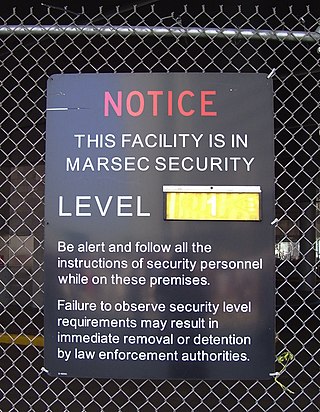Homeland security is an American national security term for "the national effort to ensure a homeland that is safe, secure, and resilient against terrorism and other hazards where American interests, aspirations, and ways of life can thrive" to the "national effort to prevent terrorist attacks within the United States, reduce the vulnerability of the U.S. to terrorism, and minimize the damage from attacks that do occur." According to an official work published by the Congressional Research Service in 2013, the "Homeland security" term's definition has varied over time.

The United States Department of Homeland Security (DHS) is the U.S. federal executive department responsible for public security, roughly comparable to the interior or home ministries of other countries. Its stated missions involve anti-terrorism, border security, immigration and customs, cyber security, and disaster prevention and management.

Thomas Joseph Ridge is an American politician and author who served in the George W. Bush administration as the Assistant to the President for Homeland Security from 2001 to 2003 and as the United States Secretary of Homeland Security from 2003 to 2005. He was the first person to hold either office. A member of the Republican Party, he previously served in the United States House of Representatives from 1983 to 1995 and as the 43rd governor of Pennsylvania from 1995 to 2001.

The United States secretary of homeland security is the head of the United States Department of Homeland Security, the federal department tasked with ensuring public safety in the United States. The secretary is a member of the Cabinet of the United States. The position was created by the Homeland Security Act following the attacks of September 11, 2001.

Janet Ann Napolitano is an American politician, lawyer, and academic administrator. She served as president of the University of California from 2013 to 2020, on the faculty at the Goldman School of Public Policy at the University of California, Berkeley since 2015, the United States secretary of homeland security from 2009 to 2013, and the governor of Arizona from 2003 to 2009.

The defense readiness condition (DEFCON) is an alert state used by the United States Armed Forces. For security reasons, the US military does not announce a DEFCON level to the public.

In the United States, the Homeland Security Advisory System (HSAS) was a color-coded terrorism threat advisory scale created in March 2002 under the Bush administration in response to the September 11 attacks. The different levels triggered specific actions by federal agencies and state and local governments, and they affected the level of security at some airports and other public facilities. It was often called the "terror alert level" by the U.S. media. The system was replaced on April 27, 2011, with a new system called the National Terrorism Advisory System.

The Homeland Security Act (HSA) of 2002, was introduced in the aftermath of the September 11 attacks and subsequent mailings of anthrax spores. The HSA was cosponsored by 118 members of Congress. The act passed the U.S. Senate by a vote of 90–9, with one Senator not voting. It was signed into law by President George W. Bush in November 2002.

The U.S. House Committee on Homeland Security is a standing committee of the United States House of Representatives. Its responsibilities include U.S. security legislation and oversight of the Department of Homeland Security.
In the United States, fusion centers are designed to promote information sharing at the federal level between agencies such as the Federal Bureau of Investigation, the U.S. Department of Homeland Security, the U.S. Department of Justice, and state, local, and tribal law enforcement. As of February 2018, the U.S. Department of Homeland Security recognized 79 fusion centers. Fusion centers may also be affiliated with an emergency operations center that responds in the event of a disaster.

MARSEC is the North American three-tiered Maritime Security system. It is used by both Canada and United States. United States Coast Guard designed it to easily communicate to the Coast Guard and the maritime industry pre-planned scalable responses for credible threats. Its objective is to provide an assessment of possible terrorist activity within the maritime sectors of transportation, including threats to nautical facilities and vessels falling within the jurisdiction of the United States and Canada that could be targets of attack.
Terror alert systems are standardised emergency population warning systems for describing and disseminating information about terrorism-related threats. They became more popular after the September 11 attacks on the United States in 2001.
Daveed Gartenstein-Ross is an author and the founder and chief executive officer of Valens Global. In addition to his role at Valens Global, Dr. Gartenstein-Ross is a Senior Advisor on Asymmetric Warfare at the Foundation for Defense of Democracies. An internationally-recognized expert on political violence, his work primarily focuses on the development of strategic plans, execution of analytic projects, and instruction at the professional and academic levels. In 2011, Gartenstein-Ross wrote Bin Laden's Legacy: Why We're Still Losing the War on Terror.

The United Kingdom Terror Threat Levels, often referred to as UK Threat Levels, are the alert states that have been in use since 1 August 2006 by the British government to warn of forms of terrorist activity. In September 2010 the threat levels for Northern Ireland-related terrorism were also made available. In July 2019 changes were made to the terrorism threat level system, to reflect the threat posed by all forms of terrorism, irrespective of ideology. There is now a single national threat level describing the threat to the UK, which includes Islamist, Northern Ireland, left-wing and right-wing terrorism. Before 2006, a colour-based alert scheme known as BIKINI state was used. The response indicates how government departments and agencies and their staffs should react to each threat level.

Caryn Wagner was the Department of Homeland Security’s Under Secretary of Homeland Security for Intelligence and Analysis from February 11, 2010, to December 21, 2012. As such, she was DHS's Chief Intelligence Officer (CINT), in charge of the DHS Office of Intelligence and Analysis with responsibilities over the DHS component intelligence services. She was the first woman to serve in this position, after extensive experience in the U.S. Intelligence Community and on Capitol Hill.

Juliette N. Kayyem is an American former government official and author. She is host of the Boston-based radio channel WGBH (FM)'s podcast The SCIF, and has also appeared on CNN and Boston Public Radio, and written columns for The Boston Globe.

Homeland Security Grant Program (HSGP) is a program in the United States established in 2003 and was designated to incorporate all projects that provide funding to local, state, and Federal government agencies by the Department of Homeland Security. The purpose of the grants is to purchase surveillance equipment, weapons, and advanced training for law enforcement personnel in order to heighten security. The HSGP helps fulfill one of the core missions of the Department of Homeland Security by enhancing the country's ability to prepare for, prevent, respond to and recover from potential attacks and other hazards. The HSGP is one of the main mechanisms in funding the creation and maintenance of national preparedness, which refers to the establishment of plans, procedures, policies, training, and equipment at the Federal, State, and local level that is needed to maximize the ability to prevent, respond to, and recover from major events such as terrorist attacks, major disasters, and other emergencies. The HSGP's creation stemmed from the consolidation of six original projects that were previously funded by the Office of State and Local Government Coordination and Preparedness. The HSGP now encompasses five projects in the program: State Homeland Security Program, Urban Areas Security Initiative, Operation Stonegarden, Metropolitan Medical Response System Program, and Citizen Corps Program. During the 2010 fiscal year, the Department of Homeland Security will spend $1,786,359,956 on the Homeland Security Grant Program.
Islamic extremism in the United States comprises all forms of Islamic extremism occurring within the United States. Islamic extremism is an adherence to fundamentalist interpretations of Islam, potentially including the promotion of violence to achieve political goals. In the aftermath of the September 11, 2001 terror attacks, Islamic extremism became a prioritized national security concern of the U.S. government and a focus of many subsidiary security and law enforcement entities. Initially, the focus of concern was on foreign Islamic terrorist organizations, particularly al-Qaeda, but in the course of the years since the September 11 terror attacks, the focus has shifted more towards Islamic extremist radicalized individuals and jihadist networks within the United States.
National Urban Security Technology Laboratory is a United States government-owned, government-operated laboratory, part of the Department of Homeland Security (DHS) Science & Technology Directorate. It is located in the Federal Office Building at 201 Varick Street in the Hudson Square neighborhood, Manhattan, New York.
Intelligence sharing is "the ability to exchange intelligence, information, data, or knowledge among Federal, state, local or private-sector entities as appropriate." Intelligence sharing also involves intergovernmental bilateral or multilateral agreements and through international organizations. Intelligence sharing is meant to facilitate the use of actionable intelligence to a broader range of decision-makers.












